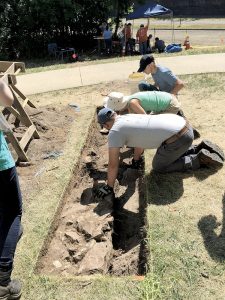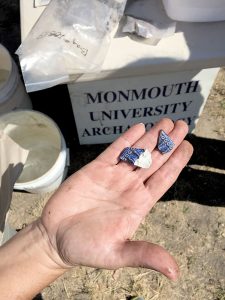By Allison Perrine
SANDY HOOK – With the noonday sun beating down on them, a group of students from Monmouth University (MU) scraped the earth at the foot of the Sandy Hook lighthouse with mini-shovels and brushes. They were digging holes in an effort to discover evidence of Revolutionary War history.
The program held June 18, 25 and 26 was a project by the university and the National Park Service to introduce archaeology to students and community volunteers. What they found intrigued them. Musket balls, pottery, bottles and more.
Rumson resident and MU graduate student Nicky Kelly got a chance to handle the century-old artifacts. “It helps to tell the whole story,” she said.
Richard Veit, the archaeology professor at MU who helped orchestrate the event, said, “It’s a wonderful opportunity to learn about one of New Jersey’s historic sites and it’s cool to have artifacts from the Revolution that gave insight into the people’s lives from that time.”
The site was roped off into five units and later broke ground for a sixth. The first unit, called “excavation unit one,” is believed to have been part of the lighthouse keeper’s home, according to MU student Elliott Wilson, 22, of Cranbury. “We think it’s the corner of the cellar, which likely would have stored cold items for the lightkeeper,” Wilson said.

Unit two appears to be the former curb-line of the road, a theory supported by the possible trail that lead to the old horse carriage house. Artifacts found in the unit included a hand-blown wine bottle, a pin, shell-edge pottery and stoneware. “This is definitely evidence of human activity,” said MU graduate student Mike Brennan of Fair Haven.
On the top of the hill Marilyn Scherfen, of Atlantic Highlands, and Marjorie Charlton, of Somerset County, worked on unit three as volunteers. “What’s beautiful is that you find everyday items (such as a Château-Lafite bottle), but also things like musket balls,” Scherfen said.
At unit five, recent MU graduate/volunteer Mark Schulze, 22, of Belford, speculated on what wall they were unearthing. “We’re trying to expose a corner of a wall and see where it leads,” he said. “We’ll dig down a foot or two and see if we can get to the bottom of it.”
After artifacts were discovered, the team labeled and placed them carefully in bags to bring to the artifact washing station. There, findings were delicately washed several times with a toothbrush so that nothing was damaged. Kelly and Samantha Muller, 41, from Rutgers University, worked at this station.
Students seemed to have enjoyed the experience.

two pieces of pottery that were found during the excavation.
“I loved it,” said MU student John Brown, 21, of Wildwood Crest. “You learn so much more in the field than you ever could in a classroom. You hear about what to do all the time in class – but to actually have the opportunity to do it is valuable,” Brown said.














